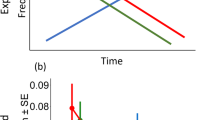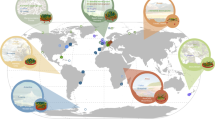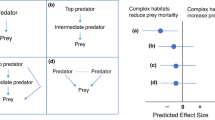Abstract
There are many cases where animal populations are affected by predators and resources in terrestrial ecosystems1,2,3, but the factors that determine when one or the other predominates remain poorly understood4,5. Here we show, using 40 years of data from the highly diverse mammal community of the Serengeti ecosystem, East Africa, that the primary cause of mortality for adults of a particular species is determined by two factors—the species diversity of both the predators and prey and the body size of that prey species relative to other prey and predators. Small ungulates in Serengeti are exposed to more predators, owing to opportunistic predation, than are larger ungulates; they also suffer greater predation rates, and experience strong predation pressure. A threshold occurs at prey body sizes of ∼150 kg, above which ungulate species have few natural predators and exhibit food limitation. Thus, biodiversity allows both predation (top-down) and resource limitation (bottom-up) to act simultaneously to affect herbivore populations. This result may apply generally in systems where there is a diversity of predators and prey.
This is a preview of subscription content, access via your institution
Access options
Subscribe to this journal
Receive 51 print issues and online access
$199.00 per year
only $3.90 per issue
Buy this article
- Purchase on Springer Link
- Instant access to full article PDF
Prices may be subject to local taxes which are calculated during checkout




Similar content being viewed by others
References
Persson, L. Trophic cascades: Abiding heterogeneity and the trophic level concept at the end of the road. Oikos 85, 385–397 (1999)
Terborgh, J. et al. Ecological meltdown in predator-free forest fragments. Science 294, 1923–1926 (2001)
Sinclair, A. R. E. et al. Testing hypotheses of trophic level interactions: A boreal forest ecosystem. Oikos 89, 313–328 (2000)
Polis, G. A. Why are parts of the world green: Multiple factors control productivity and the distribution of biomass. Oikos 86, 3–15 (1999)
Dyer, L. A. & Letourneau, D. K. Trophic cascades in a complex terrestrial community. Proc. Natl Acad. Sci. USA 96, 5072–5076 (1999)
Hairston, N. G., Smith, F. E. & Slobodkin, L. B. Community structure, population control, and competition. Am. Nat. 94, 421–424 (1960)
Hunter, M. D. & Price, P. W. Playing chutes and ladders: Heterogeneity and the relative roles of bottom-up and top-down forces in natural communities. Ecology 73, 724–732 (1992)
Post, E., Peterson, R. O., Stenseth, N. C. & McLaren, B. E. Ecosystem consequences of wolf behavioural response to climate. Nature 401, 905–907 (1999)
Schoener, T. W. & Spiller, D. A. Devastation of prey diversity by experimentally introduced predators in the field. Nature 381, 691–694 (1996)
Sinclair, A. R. E. & Norton-Griffiths, M. (eds) Serengeti: Dynamics of an Ecosystem (Univ. Chicago Press, Chicago, 1979)
Schaller, G. B. The Serengeti Lion: A Study of Predator-Prey Relations (Univ. Chicago Press, Chicago, 1972)
Bertram, B. C. R. in Serengeti: Dynamics of an Ecosystem (eds Sinclair, A. R. E. & Norton-Griffiths, M.) 221–248 (Univ. Chicago Press, Chicago, 1979)
Elliot, J. P., Cowan, I. McT. & Holling, C. S. Prey capture of the African lion. Can. J. Zool. 55, 1811–1828 (1977)
Brashares, J. S. & Arcese, P. in The Mammals of Africa (eds Kingdon, J., Happold, D. & Butynski, T.) (Academic, London, in the press)
Scheel, D. & Packer, C. in Serengeti II: Dynamics, Management, and Conservation of an Ecosystem (eds Sinclair, A. R. E. & Arcese, P.) 299–314 (Univ. Chicago Press, Chicago, 1995)
Hofer, H. & East, M. in Serengeti II: Dynamics, Management, and Conservation of an Ecosystem (eds Sinclair, A. R. E. & Arcese, P.) 332–363 (Univ. Chicago Press, Chicago, 1995)
Sinclair, A. R. E. in Serengeti: Dynamics of an Ecosystem (eds Sinclair, A. R. E. & Norton-Griffiths, M.) 82–103 (Univ. Chicago Press, Chicago, 1979)
Sinclair, A. R. E. Does interspecific competition or predation shape the African ungulate community? J. Anim. Ecol. 54, 899–918 (1985)
Sinclair, A. R. E. in Serengeti II: Dynamics, Management, and Conservation of an Ecosystem (eds Sinclair, A. R. E. & Arcese, P.) 194–219 (Univ. Chicago Press, Chicago, 1995)
Mduma, S. A. R., Sinclair, A. R. E. & Hilborn, R. Food regulates the Serengeti wildebeest: A 40-year record. J. Anim. Ecol. 68, 1101–1122 (1999)
Kruuk, H. The Spotted Hyena: A Study of Predation and Social Behavior (Univ. Chicago Press, Chicago, 1972)
Lamprecht, J. On diet, foraging behavior and interspecific food competition of jackals in the Serengeti National Park, East Africa. Z. Saugetierk 43, 210–223 (1978)
Broten, M. D. & Said, M. in Serengeti II: Dynamics, Management, and Conservation of an Ecosystem (eds Sinclair, A. R. E. & Arcese, P.) 169–193 (Univ. Chicago Press, Chicago, 1995)
Dunne, J. A., Williams, R. J. & Martinez, N. D. Network structure and biodiversity loss in food webs: Robustness increases with connectance. Ecol. Lett. 5, 558–567 (2002)
Dyer, L. A. & Letourneau, D. K. Top-down and bottom-up diversity cascades in detrital vs. living food webs. Ecol. Lett. 6, 60–68 (2003)
Nowak, R. M. Walker's Mammals of the World (Johns Hopkins, Baltimore, 1999)
Mduma, S. A. R. in Serengeti II: Dynamics, Management, and Conservation of an Ecosystem (eds Sinclair, A. R. E. & Arcese, P.) 220–230 (Univ. Chicago Press, Chicago, 1995)
Jolly, G. M. Sampling methods for aerial census of wildlife populations. E. Afr. Agric. For. J. 34, 46–49 (1969)
Cochran, W. G. Sampling Techniques (Wiley, New York, 1963)
Campbell, K. & Borner, M. in Serengeti II: Dynamics, Management, and Conservation of an Ecosystem (eds Sinclair, A. R. E. & Arcese, P.) 117–145 (Univ. Chicago Press, Chicago, 1995)
Acknowledgements
We thank the Tanzania Wildlife Research Institute and Tanzania National Parks for facilitating our research in Serengeti. We thank NSERC Canada and the National Geographic Society for funding.
Author information
Authors and Affiliations
Corresponding author
Ethics declarations
Competing interests
The authors declare that they have no competing financial interests.
Supplementary information
Rights and permissions
About this article
Cite this article
Sinclair, A., Mduma, S. & Brashares, J. Patterns of predation in a diverse predator–prey system. Nature 425, 288–290 (2003). https://doi.org/10.1038/nature01934
Received:
Accepted:
Issue Date:
DOI: https://doi.org/10.1038/nature01934
This article is cited by
-
Do domestic budgerigars perceive predation risk?
Animal Cognition (2024)
-
Linking movement and dive data to prey distribution models: new insights in foraging behaviour and potential pitfalls of movement analyses
Movement Ecology (2023)
-
Comparable GHG emissions from animals in wildlife and livestock-dominated savannas
npj Climate and Atmospheric Science (2023)
-
Can smaller predators expand their prey base through killing juveniles? The influence of prey demography and season on prey selection for cheetahs and lions
Oecologia (2023)
-
Herbivory baseline estimates in Spanish protected areas, and environmental implications
Landscape Ecology (2023)
Comments
By submitting a comment you agree to abide by our Terms and Community Guidelines. If you find something abusive or that does not comply with our terms or guidelines please flag it as inappropriate.



